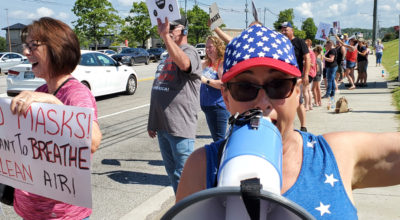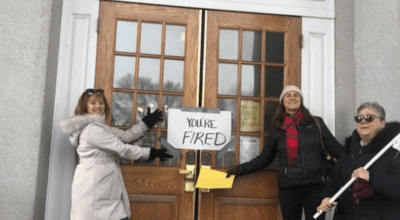
As Gov. Bill Lee considers the state’s role in proper management of internment camps, he will turn to Centers for Disease Control for advice on how to run them efficiently.
By David Tulis / NoogaRadio 92.7 FM
The CDC on July 26, 2020, updated its “interim operational considerations for implementing the Shielding Approach to prevent Covid-19 infections in humanitarian settings,” a document available to Gov. Lee that intends to make camp life bearable for the inmates.
Gov. Lee in executive order No. 83 requires easing of building rules for internment camps. By law only sick people who refuse to isolate are confined in the camps, and can force the state to sue them in court before having to comply. But Gov. Lee has rejected the quarantine and isolation statute at Tenn. Code Ann. § 68-5-104, with its due process protections built in, and can be counted on to put healthy people into confinement, just as he put healthy people under house arrest by order April 2, 2020, with his “stay at home” executive order No. 23.
The “shielding approach” segregates high- and the low-risk members of the population. The elderly are high risk. But also people who are sick — “people of any age who have serious underlying medical conditions are at higher risk for severe illness.” They are “temporarily relocarted to safe or ‘green zones’ established at the household, neighborhood, camp/sector or community level.”
Gov. Lee is advised that “implementation *** necessitates strict adherence” to the CDC guidelines.
Latrines, washing areas
If you and your family are subjected to “the shielding approach” of public care which aims to reduce CV19, you are being confined for your own good, even though you are “non-symptomatic,” or healthy. A person who is healthy, it appears from the text, could be deemed “high risk,” virgin territory in not having had CV-19.
Among the benefits of camp life will be latrines near dwelling structures, washing facilities, “proper lighting,” chin diaper dispensaries, disinfectant supplies and ventilators and psychological counseling.
Camps also will have beds with linens. People will have “dishes/utensils” for meals and be able to draw potable water from state-supplied containers.
Globally, governments and fiat-money floated national economies are on the verge of imploding, crippled by graft, corruption and surplus violence, surplus law, surplus programming. Given the arrival of these conditions, the CDC seems to realize that officials overseeing the camps and supportive families outside the barbed wire may have trouble obtaining groceries and supplies to make camp life bearable.
Considering global reductions in commodity shortages, movement restrictions, border closures, and decreased trucking and flights, it is important to outline what additional resources will be needed and how they will be procured.
This scene of American descent into a post-U.S. neo-medievalism is posited by writers such as Charles Hugh Smith at Oftwominds.com and by James Howard Kunstler in his two “long emergency” books. Mr. Kunstler’s work is routinely on a most vital website, the anti-war, anti-state and pro-market Lewrockwell.com.
Many small encampments
History indicates camps can get easily overcrowded, especially in time of war or unrest. But CDC envisions a maximum of 10 HHs (or households) “within a small camp or area where high-risk members are grouped together.”

Liberty groups are projecting citizen roundups, compulsory inoculations and that the EO “is laying the groundwork for permanent lockdowns. “FALSE,” says Gov. Lee’s legislative liaison Brent Easley. He says rumors about concentration camps are “demonstrably false” and that “key provisions” of the EO are “being misinterpreted.” Tennessee national guard members “are committed to serving their neighbors,” he says, implying they would never follow orders to take healthy people to camps.
Wisely, the CDC paper says the scheme is not final and that “monitoring protocols will need to be developed for each type of green zone.”
Such monitoring will add to the state payroll. “Dedicated staff need to be identified to monitor each green zone. Monitoring includes both adherence to protocols and potential adverse effects or outcomes due to isolation and stigma. It may be necessary to assign someone within the green zone, if feasible, to minimize movement in/out of green zones.”
The CDC realizes that a depopulation project — of the sort used by Babylonians and other ancient empires in conquered areas to thwart revolts — will have high social and psychical costs on individuals in new surroundings.
[I]n addition to the risk of stigmatization and feeling of isolation, this shielding approach may have an important psychological impact and may lead to significant emotional distress, exacerbate existing mental illness or contribute to anxiety, depression, helplessness, grief, substance abuse, or thoughts of suicide among those who are separated or have been left behind.
‘Loss of freedom’
The CDC wants inmates to identify with their camp and contribute to its improvement, to make it more like home, to enhance “community acceptance and involvement in the design and implementation.”
Even with community involvement, there may be a risk of stigmatization. Isolation/separation from family members, loss of freedom and personal interactions may require additional psychosocial support structures/systems.
Children and teenagers pose special problems in the CV-19 camps the Lee administration is authorized by Title 68 to build. “High-risk minors should be accompanied into isolation by a single caregiver who will also be considered a green zone resident in terms of movements and contacts with those outside the green zone.” The CDC says “protection measures are critical” and that “appropriate, adequate, and acceptable care” be available for minors, especially those “with disabilities or mental health conditions who remain in the HH if separated from their primary caregiver.”
Comet, brillo pads, ‘human resource support’
People destined for such camps should be comforted to know that a CDC green zone does not discriminate. People with disabilities will be in the camps, and will need extra attention and cleaning supplies such as Comet, brillo pads and buckets.
High-risk individuals will be responsible for cleaning and maintaining their own living space and facilities. This may not be feasible for persons with disabilities or decreased mobility. Maintaining hygiene conditions in communal facilities is difficult during non-outbreak settings. [C]onsequently it may be necessary to provide additional human resource support.
The camps won’t be the exclusive zones of gray-heads, but the young. Green zone camps will be prone to rape and sexual abuse, aka “gender-based violence.” State governments in the U.S. have long trafficked in children, with criminality and sex abuse rampant. The human services department is aware of the danger of abuse in broken homes of the sort represented by a green zone camp.
Camp bosses will be required to give special attention to sexual abuse, which one article cited in a footnote describes variously as “human trafficking to sexual services, engagement in transactional and survival sex, engaging in unsafe sex work.”
The CDC has its fingertip on the pulse on societal breakdown represented by “community interventions meant to decrease COVID-19 morbidity and mortality.”
Separating families and disrupting and deconstructing multigenerational households may have long-term negative consequences. Shielding strategies need to consider sociocultural gender norms in order to adequately assess and address risks to individuals, particularly women and girls. Restrictive gender norms [traditional and Christian perspective on life] may be exacerbated by isolation strategies such as shielding.
At the household level, isolating individuals and limiting their interaction, compounded with social and economic disruption has raised concerns of potential increased risk of partner violence. Households participating in house swaps or sector-wide cohorting are at particular risk for gender-based violence, harassment, abuse, and exploitation as remaining household members may not be decision-makers or responsible for households needs.
(Emphasis added)
The language in the document is as blank-eyed as it is totalistic, proposing the management of newly created human society in the context of an internment camp. The style is abstract, agentless, passive, detached, the form of writing by social engineers, planners and academicians.
The CDC is responsible for shutting hundreds of churches across the U.S. as its advisories became law in governor’s offices and state bureaucracies. That doesn’t mean CDC is insensitive to religion. Religious holidays, funerals and other “rites of passage” are “cornerstones” of society. It warns of “interpersonal and communal violence” if planners fail to “understand the issues and concerns of restricting individuals from participating in communal practices [church, religion, worship] because they are being shielded.”

The CDC report is written, effectively, in pencil, subject to erasures and edits by governors who bring it to life extemporaneously and on the fly, as they have everything else about the CV-19 disaster. “[T]here is no empirical evidence whether this approach will increase, decrease or have no effect” on CV-19 rates. The CDC doesn’t want the appearance of coercion to control, but its good intentions. “The shielding approach is not meant to be coercive,” the CDC says, but “it may appear forced or be misunderstood in humanitarian settings.”
https://www.cdc.gov/coronavirus/2019-ncov/global-covid-19/shielding-approach-humanitarian.html
The group doesn’t promise results for Gov. Lee if he uses the study to train case managers, property overseers, camp district directors, quartermasters and staff people to handle the prospect of hundreds of such facilities going up.
Fraud admitted in court case
The lawsuit seeking to compel Gov. Lee and Hamilton County health administrator Becky Barnes to obey the quarantine and isolation law in Tennessee is being heard by court of appeals judges at 505 Main St. in Knoxville. My brief is due Sept. 6.
Martial law is forbidden by law in Tennessee, yet Gov. Lee resorted to it with his fraudulent state of emergency March 12, 2020. The ban is in the bill of rights, Article 1, at section 25.
That martial law, in the sense of the unrestricted power of military officers, or others, to dispose of the persons, liberties or property of the citizen, is inconsistent with the principles of free government, and is not confided to any department of the government of this state
I am doing all the legal work in the case, and am asking for financial support. In this legal reform project, I am often removed from the daily necessities of earning my bread as investigative reporter and broadcast journalist at NoogaRadio 92.7 FM. Please support our case via my GoFundMe page.
‡ The EO 83 paragraph that has sparked national attention is as follows:
Temporary quarantine and isolation facil ities may b constructe I. The provisions of Tennessee Code Annotated, Section 68-11-202( c )( 1 )-(8), are hereby suspended to allow for the construction of temporary structures, the plans for which would otherwise be subject to review for new construction, additions, or substantial alterations, as directed by the Commissioner of Health and the Director of TEMA in response to COVID-19; provided, that there shall be inspections of such structures to ensure safety, as necessary.

.
Time to fight
.

